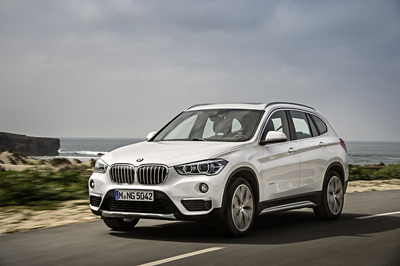First Drive Review: 2016 BMW X1 xDrive 28i by Henny Hemmes +VIDEO
By Henny Hemmes
Senior European Editor
THE AUTO CHANNEL
 2016 BMW X1 |
ACHENKIRCHEN, Austria - Next year, when the Bayerische Motor Werke celebrates its Centennial, most of its models will be rejuvenated. That also goes for the X1 that will make its world premiere at the IAA auto show in Frankfurt and goes on sale in October. But first, the completely renewed X1 was up for test drives in the Austrian Alps.
The X1 was introduced in 2009 and with 730,000 units sold worldwide, it has proved to be quite successful. Indeed, BMW has benefitted from the ever growing popularity of sport-utes in general and compact premium ones in particular, even though the Germans started selling the X1 in 2013 in its main market, North America. “The sales of the X1 were more than expected," said René de Heij, product marketing manager BMW Netherlands, whom I met shortly before my first X1 drive. But he keeps mum about the number of sales that had been expected back then, per company policy.
Bye, Bye Six-Cylinder Engine
 2016 BMW X1 |
So far, the 2 Series Active Tourer and Grand Tourer (that are only available in Europe) have not disappointed and are selling really well, and we may expect that the new configuration will turn out well for the 20i and 18d sDrive models. Front-wheel-drive is always standard for the models with the smaller engines (20i and 18d), xDrive is an option for the 20i, others and is always standard on the 25i, 20d and 28d models. With the arrival of the new engine family, the 35i model with the six-cylinder motor will not get a successor. The largest engine that will be available from the market introduction in North America on October 24th, is the xDrive28i and it will be the only one until the end of the year, when BMW shall bring another engine combined with front-wheel-drive.
 2016 BMW X1 |
Admittedly, the number 28 may hint at a 2.8 liter power plant, but under the hood of the new top model sits the 228 hp strong 2.0-liter 4-cylinder turbo motor with 350 Nm/258 pound-feet of torque. Under normal circumstances the torque goes to the front wheels, but will be transferred to the rear wheels if needed. The xDrive 28i comes standard with the 8-speed automatic transmission. The 3-cylinder engines that will be available on other markets will get a 6-speed stick shift with the 6- speed automatic. The 4-cylinder engines are always mated to the 6-speed manual or the 8-speed automatic as an option.
The M Sport package will also be available from the market launch and includes firmer and lowered suspension, sport seats and an M steering wheel.
More flexibility
 2016 BMW X1 |
 2016 BMW X1 |
Higher ground clearance, higher seating position
The interior is much nicer than the outgoing X1 and, as you may expect,
has a lot of design details that we have already seen in the face lifted 1
Series and some that come from the other BMW models. The controls,
including the latest edition of the iDrive are easy to find and use.
The driving position felt high and I adjusted the seat as low as possible, but it still felt odd. Upon my question how much the hip point (center hip of an average length person, measured from the ground up) had been raised, the answer had to be found, but it proved to be 61.1 cm (24 in.), 3.1 cm (1.2 in.) higher than before. Bear in mind that ground clearance increased from 179 to 193 mm, or 7 and 7.6 inches respectively.
Showing off
I really appreciate the fact that the new generation has an head-up
display that projects information in the windshield in front of the driver.
HUD, as it is called, is a very useful feature. You can see all relevant
data and also navigation arrows.
We drove the X1 xDrive 28i, which has the new generation all-wheel-drive, that reacts faster and smoother than before. The engine response is fast and maximum torque is already available from 1,250 rpm, which allows for a sudden sprint from nearly any speed, while the 8-speed automatic figures out the right gear. The new X1 turns well into corners, showing a little under steer only at higher speeds. Steering feels somewhat disengaged, but after a couple of hours on the road, you do not think about it anymore. That also goes for the brakes that instantly react even when you make no emergency stop. It is all a question of ‘getting-used-to’. And as often, my colleagues and I have to imagine that we are the target customers, who buy an X1 or the likes for its high seating position, nice quality and premium feel, with good handling and reliable technology. They are usually not the ones who are trying to show off as if they were Sebastian Vettel in a Formula 1 Ferrari.
Off the road in the X1 xDrive 25d
 2016 BMW X1 |
 2016 BMW X1 |
The X1 is not built in the BMW plant in Spartanburg, SC, like the X3 and X5, but in Regensburg, Germany. From there it will be exported to markets world wide and arrive in show rooms on October 24th, except for China where it can be expected in early 2016. There is no pricing yet, but with more safety and connectivity system, I expect the prices to be somewhat higher than of the outgoing model.



